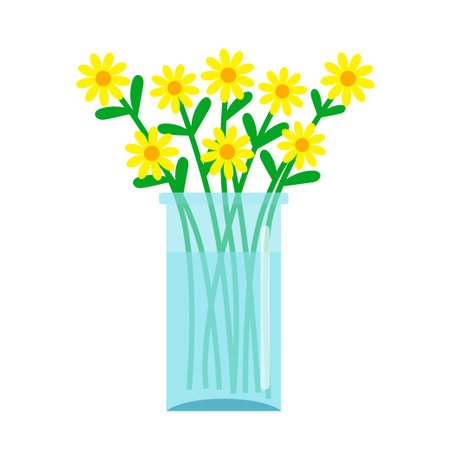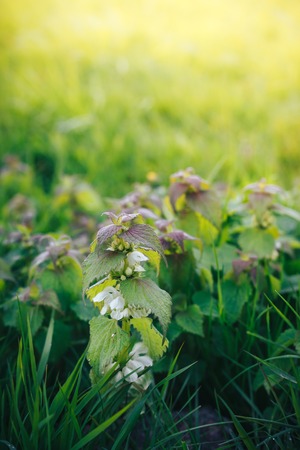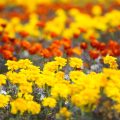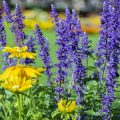1. Understanding Wildflowers and Their Benefits
Before you dig into planting your wildflower garden, its important to understand what wildflowers really are and why theyre so special. Wildflowers are flowering plants that grow naturally without much human help. Theyre often native to a specific region, meaning they’ve adapted over time to thrive in local soil, weather, and wildlife conditions. This makes them low-maintenance, drought-tolerant, and perfect for beginners.
What Makes a Flower a “Wildflower”?
A wildflower is typically a flower that grows on its own in nature without being planted or heavily managed by people. Many wildflowers are perennials (they come back every year), while others are annuals or biennials. Because they’re native or well-adapted to their environment, they usually don’t need fertilizers or pesticides to flourish.
Types of Wildflowers by U.S. Region
The U.S. is home to many different climates and ecosystems, so the types of native wildflowers vary by region. Planting flowers that are native to your area increases your chances of success and supports your local environment.
| Region | Common Native Wildflowers |
|---|---|
| Northeast | Black-eyed Susan, New England Aster, Joe-Pye Weed |
| Southeast | Coreopsis, Blanket Flower, Purple Coneflower |
| Midwest | Prairie Clover, Butterfly Weed, Wild Bergamot |
| Southwest | Desert Marigold, Blue Flax, Mexican Hat |
| West Coast | California Poppy, Lupine, Yarrow |
| Pacific Northwest | Columbine, Oregon Sunshine, Camas Lily |
How Wildflowers Help Pollinators and the Ecosystem
Wildflowers play a big role in supporting pollinators like bees, butterflies, and hummingbirds. These pollinators rely on nectar from flowers for food—and in return, they help plants reproduce by spreading pollen. A wildflower garden creates a habitat for these helpful creatures and encourages biodiversity right in your backyard.
Benefits of Growing Wildflowers:
- Supports pollinators: Provides food and shelter for bees, butterflies, and birds.
- Improves soil health: Deep roots help prevent erosion and improve soil structure.
- Low maintenance: Once established, wildflowers require less water and care than traditional lawns.
- Adds natural beauty: Offers vibrant colors and seasonal variety.
- Saves money: Reduces the need for fertilizers, pesticides, and frequent watering.
A Natural Choice for Sustainable Gardening
If you’re looking for an easy way to beautify your yard while helping the planet, starting with native wildflowers is a great first step. In the next section, we’ll cover how to choose the right spot in your yard for planting your wildflower garden.
2. Choosing the Right Location for Your Wildflower Garden
Picking the perfect spot for your wildflower garden is one of the most important steps to ensure your flowers grow healthy and strong. Wildflowers are known for being low-maintenance, but they still need the right conditions to thrive. Here are some key things to think about when choosing a location.
Sunlight Requirements
Most wildflowers love full sun, which means they need at least 6 hours of direct sunlight per day. However, some varieties can tolerate partial shade. Before planting, observe how much sunlight different areas of your yard receive throughout the day.
| Sunlight Level | Ideal For |
|---|---|
| Full Sun (6+ hours) | Most wildflower species like poppies, black-eyed Susans, and coneflowers |
| Partial Shade (3–6 hours) | Shade-tolerant varieties like woodland phlox and columbine |
| Full Shade (<3 hours) | Not ideal for wildflowers; consider another type of garden here |
Soil Type and Drainage
Wildflowers are adaptable, but good soil drainage is essential. Heavy clay or constantly wet areas can prevent seeds from germinating or cause roots to rot. If you’re unsure about your soil type, take a handful of dirt and squeeze it—if it forms a sticky ball, its likely clay. Sandy or loamy soils work best for most wildflowers.
| Soil Type | Description | Suitability for Wildflowers |
|---|---|---|
| Sandy Soil | Light, drains quickly | Great with added compost or organic matter |
| Loamy Soil | Balanced texture, holds moisture well but drains easily | Ideal for wildflowers |
| Clay Soil | Dense, retains water, poor drainage | Poor unless amended with compost or sand |
Available Space and Design Ideas
You don’t need a huge backyard to start a wildflower garden. A small patch in your front yard, a corner along a fence line, or even raised beds can work well. Consider how much space you have and what kind of look you want—whether it’s a natural meadow style or a more organized layout with walking paths.
Tips for Small Spaces:
- Use containers or window boxes with compact wildflower mixes.
- Create vertical interest with trellises and climbing native plants.
- Select region-specific seed blends that suit limited areas.
Bonus Tip:
If youre not sure where to start, try marking potential spots with stakes and watching how the sun hits them over a few days. This will help you choose the best location before you plant any seeds.
The right location sets the stage for a vibrant, low-maintenance wildflower garden that supports pollinators and adds natural beauty to your outdoor space.

3. Preparing the Soil and Planning Your Layout
Before you start planting wildflowers, it’s important to prepare your soil and plan your garden layout. This step sets the foundation for a thriving, low-maintenance wildflower garden that looks great and supports local pollinators.
Clearing Existing Vegetation
Start by removing any grass, weeds, or other unwanted plants from your chosen site. You can do this manually with a shovel or hoe, or use a sod cutter for larger areas. Another option is to smother vegetation using cardboard or black plastic sheeting for several weeks until everything underneath dies off. Avoid using chemical herbicides if youre aiming for an eco-friendly garden.
Testing and Amending Your Soil
Wildflowers are hardy, but knowing your soil type helps you choose the right seed mix and improves growing conditions. Use a basic soil test kit (available at most garden centers) to check for:
| Soil Characteristic | What to Look For | Suggestions |
|---|---|---|
| pH Level | Neutral to slightly acidic (6.0–7.0) | Add lime to raise pH, sulfur to lower it |
| Drainage | Well-draining soil is ideal | Add compost or sand to improve drainage |
| Nutrients | Moderate nutrient levels | Avoid over-fertilizing; wildflowers thrive in lean soil |
Amending the Soil (If Needed)
If your soil is compacted or lacks organic matter, mix in compost or aged manure. Tilling lightly can help incorporate amendments, but avoid deep tilling which may bring up dormant weed seeds.
Planning Your Garden Layout
A well-thought-out layout not only makes your garden visually appealing but also promotes healthy growth and sustainability.
Consider Sunlight and Drainage
Most wildflowers need full sun—at least 6 hours per day. Observe how sunlight moves across your yard and place sun-loving species accordingly. Also consider drainage patterns; avoid planting in spots that stay soggy after rain.
Create Groupings for Impact
Cluster similar wildflower species together to create bold patches of color and make it easier for pollinators to find them. Mixing heights also adds visual interest—taller flowers can go in the back or center, with shorter varieties around the edges.
Add Paths and Borders
Incorporate natural-looking paths using mulch or stepping stones so you can enjoy your garden without stepping on plants. Consider adding native grasses or low-growing groundcovers around the edges for a clean finish.
Tip:
Sketch out your layout on paper before planting—it doesnt have to be fancy, just enough to guide you when it’s time to sow seeds!
4. Selecting and Sowing Wildflower Seeds
Choosing the right wildflower seeds is one of the most exciting parts of starting your garden. The key is to select native or region-specific seed mixes that will thrive in your local climate and soil conditions. Native wildflowers not only adapt better but also support local pollinators like bees, butterflies, and birds.
How to Choose the Right Seeds
Start by identifying your USDA hardiness zone and the type of environment your garden offers—full sun, partial shade, dry or moist soil. Based on this information, you can pick a seed mix tailored to your region. Here’s a quick guide:
| Region | Recommended Seed Mix Type | Popular Native Wildflowers |
|---|---|---|
| Northeast | Cool-season native mix | Black-eyed Susan, New England Aster, Joe-Pye Weed |
| Southeast | Warm-season native mix | Coreopsis, Blanket Flower, Purple Coneflower |
| Midwest | Prairie or tallgrass mix | Bergamot, Butterfly Milkweed, Wild Indigo |
| Southwest | Drought-tolerant desert mix | Desert Marigold, Indian Blanket, Blue Flax |
| West Coast | Mediterranean-climate mix | California Poppy, Tidy Tips, Lupine |
When to Plant Wildflower Seeds
The best time to sow wildflower seeds depends on your regions climate:
- Fall planting (September–November): Great for most regions. Seeds lie dormant over winter and bloom in spring.
- Spring planting (March–May): Ideal for colder climates where winters are harsh.
- Summer planting: Not recommended unless you have access to irrigation and choose heat-tolerant species.
Sowing Your Seeds: Step-by-Step Guide
1. Prepare the Soil
Clear the area of grass, weeds, and debris. Loosen the top few inches of soil using a rake or hoe. You don’t need fertilizer—wildflowers prefer lean soil.
2. Mix Seeds with Sand
This helps distribute seeds more evenly. Use a ratio of 1 part seed to 4 parts sand.
3. Scatter Seeds Evenly
Broadcast seeds by hand or use a handheld spreader. Try to cover the area as evenly as possible.
4. Press Seeds into Soil
You can walk over the area or use a roller to ensure good seed-to-soil contact. Don’t bury them; most wildflower seeds need light to germinate.
5. Water Gently
Mist the area lightly with water immediately after sowing. Keep the soil moist—but not soggy—until seedlings are established (usually about 4–6 weeks).
Caring for Your Seedlings
Avoid heavy watering or foot traffic during early growth stages. Once established, wildflowers are generally low-maintenance and drought-tolerant.
This step sets the foundation for a beautiful and thriving wildflower garden tailored to your unique environment.
5. Maintaining and Enjoying Your Wildflower Garden
Now that your wildflower garden is up and blooming, it’s time to keep it thriving! A little bit of regular care will go a long way in making sure your garden stays healthy, colorful, and full of life season after season. Heres what you need to know about weeding, watering, and seasonal maintenance.
Weeding: Keep the Unwanted Guests Out
Weeds can compete with your wildflowers for nutrients, sunlight, and water. In the early stages of your garden, its especially important to remove any unwanted plants so your flowers can take hold. Hand-pulling is often the best method, especially around young seedlings. Avoid using chemical herbicides—they can harm your wildflowers and local pollinators.
Tips for Easy Weeding:
- Weed after it rains—the soil is softer and roots come out easier.
- Use mulch or straw between flower patches to suppress weeds naturally.
- Learn to identify your wildflower seedlings so you don’t accidentally pull them out!
Watering: Find the Right Balance
Wildflowers are generally low-maintenance when it comes to water, but young gardens need some help until they’re established. Once they’re rooted, many native species can thrive on natural rainfall alone.
| Growth Stage | Watering Needs |
|---|---|
| First 4-6 Weeks After Planting | Water lightly every day or every other day to keep soil moist |
| After Establishment (6+ weeks) | Water once a week during dry spells |
| Mature Garden (Year 2+) | Mainly rely on rainfall; water only during droughts |
Seasonal Care: What to Do Throughout the Year
Your wildflower garden will change with the seasons, and a few simple tasks each time of year will keep it looking its best.
Spring:
- Cut back any dead plant material from winter
- Sow new seeds if you want more blooms or fill in bare spots
- Add compost if needed for extra nutrients
Summer:
- Deadhead spent flowers to encourage more blooms
- Keep an eye out for invasive weeds
- Irrigate only during extended dry periods
Fall:
- You can leave seed heads for birds and reseeding
- Add mulch if winters are harsh in your area
- Sow fall-blooming varieties if desired
Winter:
- Avoid cutting everything back—many beneficial insects overwinter in stems and leaf litter
- If you live in a snowy area, let snow act as insulation for plant roots
The Joy of Watching It Grow
The beauty of a wildflower garden is that it changes every day. Youll see new colors pop up throughout the growing season, spot butterflies and bees buzzing around, and enjoy the peaceful feeling of nature right outside your door. With just a bit of care throughout the year, your garden will reward you with color and life for years to come.


